Álvaro Soto
Data Distributional Properties As Inductive Bias for Systematic Generalization
Feb 27, 2025



Abstract:Deep neural networks (DNNs) struggle at systematic generalization (SG). Several studies have evaluated the possibility to promote SG through the proposal of novel architectures, loss functions or training methodologies. Few studies, however, have focused on the role of training data properties in promoting SG. In this work, we investigate the impact of certain data distributional properties, as inductive biases for the SG ability of a multi-modal language model. To this end, we study three different properties. First, data diversity, instantiated as an increase in the possible values a latent property in the training distribution may take. Second, burstiness, where we probabilistically restrict the number of possible values of latent factors on particular inputs during training. Third, latent intervention, where a particular latent factor is altered randomly during training. We find that all three factors significantly enhance SG, with diversity contributing an 89\% absolute increase in accuracy in the most affected property. Through a series of experiments, we test various hypotheses to understand why these properties promote SG. Finally, we find that Normalized Mutual Information (NMI) between latent attributes in the training distribution is strongly predictive of out-of-distribution generalization. We find that a mechanism by which lower NMI induces SG is in the geometry of representations. In particular, we find that NMI induces more parallelism in neural representations (i.e., input features coded in parallel neural vectors) of the model, a property related to the capacity of reasoning by analogy.
Extracting and Encoding: Leveraging Large Language Models and Medical Knowledge to Enhance Radiological Text Representation
Jul 02, 2024
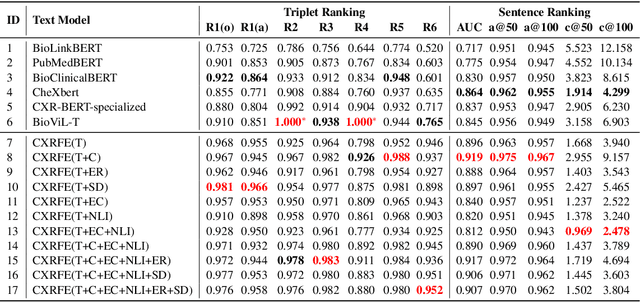

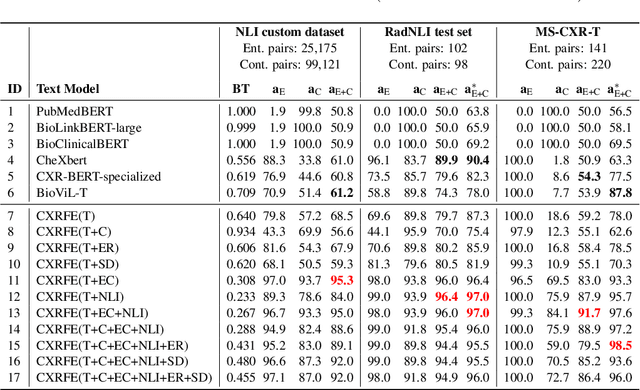
Abstract:Advancing representation learning in specialized fields like medicine remains challenging due to the scarcity of expert annotations for text and images. To tackle this issue, we present a novel two-stage framework designed to extract high-quality factual statements from free-text radiology reports in order to improve the representations of text encoders and, consequently, their performance on various downstream tasks. In the first stage, we propose a \textit{Fact Extractor} that leverages large language models (LLMs) to identify factual statements from well-curated domain-specific datasets. In the second stage, we introduce a \textit{Fact Encoder} (CXRFE) based on a BERT model fine-tuned with objective functions designed to improve its representations using the extracted factual data. Our framework also includes a new embedding-based metric (CXRFEScore) for evaluating chest X-ray text generation systems, leveraging both stages of our approach. Extensive evaluations show that our fact extractor and encoder outperform current state-of-the-art methods in tasks such as sentence ranking, natural language inference, and label extraction from radiology reports. Additionally, our metric proves to be more robust and effective than existing metrics commonly used in the radiology report generation literature. The code of this project is available at \url{https://github.com/PabloMessina/CXR-Fact-Encoder}.
Eigenpruning
Apr 04, 2024


Abstract:We introduce eigenpruning, a method that removes singular values from weight matrices in an LLM to improve its performance in a particular task. This method is inspired by interpretability methods designed to automatically find subnetworks of a model which solve a specific task. In our tests, the pruned model outperforms the original model by a large margin, while only requiring minimal computation to prune the weight matrices. In the case of a small synthetic task in integer multiplication, the Phi-2 model can improve its accuracy in the test set from 13.75% to 97.50%. Interestingly, these results seem to indicate the existence of a computation path that can solve the task very effectively, but it was not being used by the original model. Finally, we plan to open-source our implementation in the camera-ready version of our work.
Bridging the visual gap in VLN via semantically richer instructions
Oct 27, 2022Abstract:The Visual-and-Language Navigation (VLN) task requires understanding a textual instruction to navigate a natural indoor environment using only visual information. While this is a trivial task for most humans, it is still an open problem for AI models. In this work, we hypothesize that poor use of the visual information available is at the core of the low performance of current models. To support this hypothesis, we provide experimental evidence showing that state-of-the-art models are not severely affected when they receive just limited or even no visual data, indicating a strong overfitting to the textual instructions. To encourage a more suitable use of the visual information, we propose a new data augmentation method that fosters the inclusion of more explicit visual information in the generation of textual navigational instructions. Our main intuition is that current VLN datasets include textual instructions that are intended to inform an expert navigator, such as a human, but not a beginner visual navigational agent, such as a randomly initialized DL model. Specifically, to bridge the visual semantic gap of current VLN datasets, we take advantage of metadata available for the Matterport3D dataset that, among others, includes information about object labels that are present in the scenes. Training a state-of-the-art model with the new set of instructions increase its performance by 8% in terms of success rate on unseen environments, demonstrating the advantages of the proposed data augmentation method.
DACT-BERT: Differentiable Adaptive Computation Time for an Efficient BERT Inference
Sep 24, 2021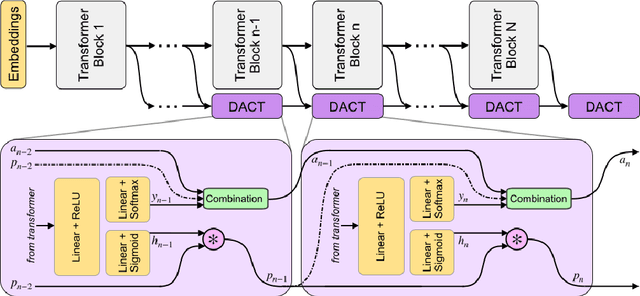
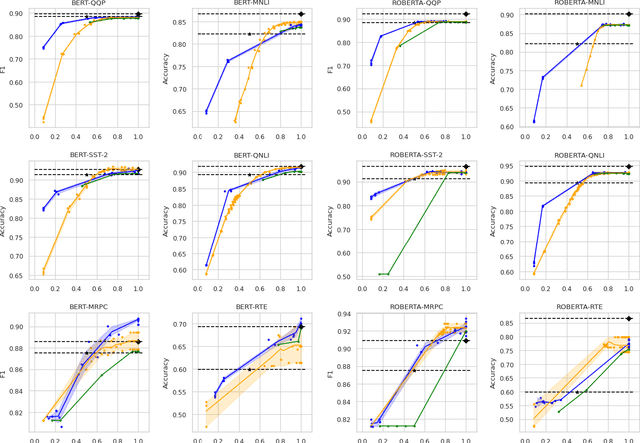
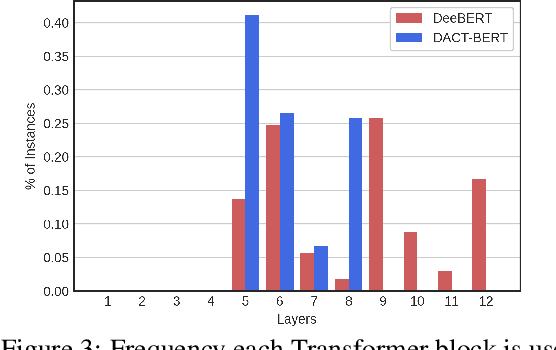
Abstract:Large-scale pre-trained language models have shown remarkable results in diverse NLP applications. Unfortunately, these performance gains have been accompanied by a significant increase in computation time and model size, stressing the need to develop new or complementary strategies to increase the efficiency of these models. In this paper we propose DACT-BERT, a differentiable adaptive computation time strategy for BERT-like models. DACT-BERT adds an adaptive computational mechanism to BERT's regular processing pipeline, which controls the number of Transformer blocks that need to be executed at inference time. By doing this, the model learns to combine the most appropriate intermediate representations for the task at hand. Our experiments demonstrate that our approach, when compared to the baselines, excels on a reduced computational regime and is competitive in other less restrictive ones.
 Add to Chrome
Add to Chrome Add to Firefox
Add to Firefox Add to Edge
Add to Edge